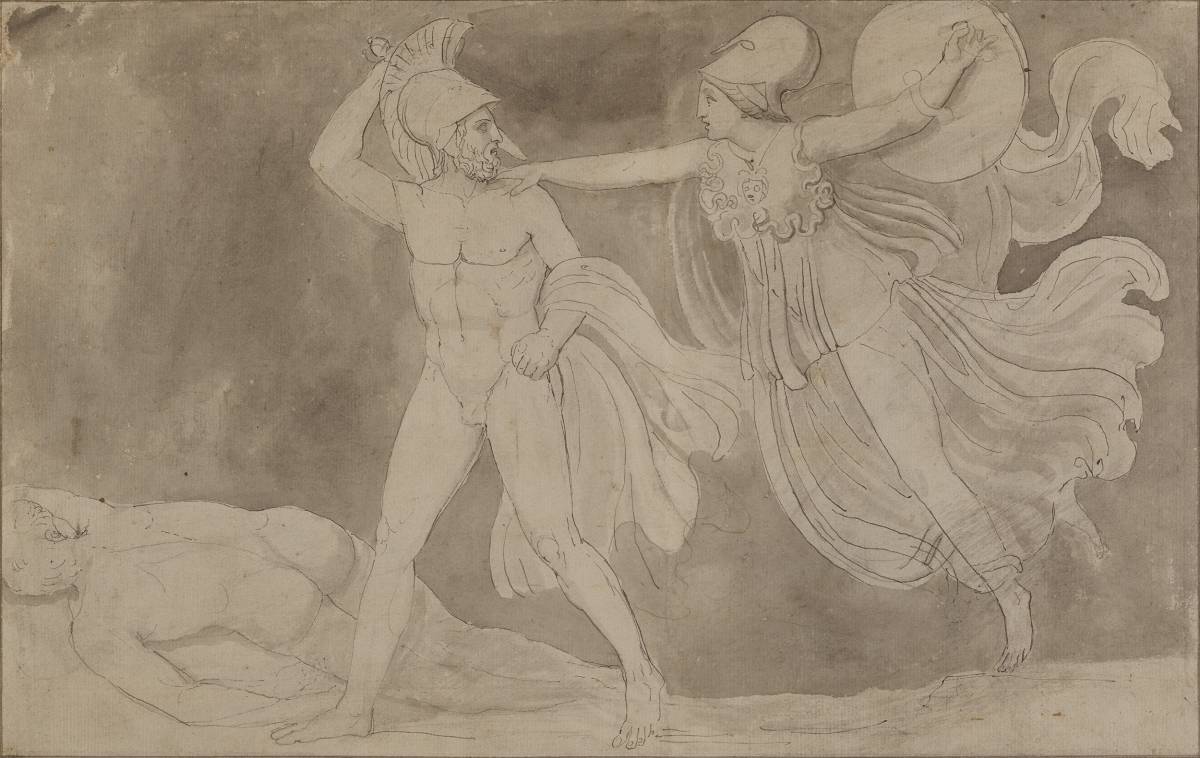This grand wash drawing was made by John Flaxman in Rome whilst he was working on the designs for his important series of illustrations to the works of Homer. The dynamic scene shows a Greek hero being restrained by Athena, drawn with characteristic fluency and economy by Flaxman. Whilst in Italy Flaxman began to prepare a series of important illustrated books and this design may well relate to Flaxman’s work on his commission for designs of the Iliad in 1792. Flaxman’s outline drawings were recognised immediately as revolutionary for their purity of outline and narrative clarity; as David Bindman has observed: ‘their influence on nineteenth-century artists is incalculable’ and copies by artists as diverse as Jacques-Louis David and Philipp Otto Runge survive.[1]
Flaxman was the son of a professional sculptor, and he received his earliest education in his father’s Covent Garden shop and studio. Flaxman’s early prodigious talents as a draughtsman attracted the attention of two of his father’s professional contacts, George Romney and Josiah Wedgwood, both of whom became important supporters. Flaxman set out for the Continent with a series of commissions, including from Josiah Wedgwood, who relied on Flaxman to supply designs for his Etruria works. One of Flaxman’s tasks was to supervise the work of John Devaere, who was being sponsored by Wedgwood to work as a modeller in Rome. In Rome Flaxman devoted himself to studying the vast store of antiquities available in the city, this included both the great sculpture available at the Capitoline and new Museo Pio Clementino in the Vatican as well as a variety of princely collections. Flaxman’s surviving sketchbooks show that he was particularly attracted to the shallow bas-reliefs found on sarcophagi noting in 1793: ‘the ancient sarcophagi [which] present a magnificent collection of compositions from the great poets of antiquity.’ It was the taut, concentrated action of Roman sarcophagi carved in bas-relief and comprised of friezes of figures which had a transformative effect on Flaxman as a designer.

John Flaxman
Preliminary studies for the "Iliad of Homer"
Pencil
10 3/8 x 7 ½ inches; 263 x 192 mm
© The Trustees of the British Museum
The present large-format sheet was made by Flaxman in Rome. Flaxman shows one of his favourite dramatic moments, a Greek hero, arm raised about to deliver a fatal blow, being restrained by Athena. The figure of the hero is indebted to one of the Dioscuri, a figure-type which appears in many Roman sarcophagi and a figure Flaxman drew on multiple occasions. The lines of the musculature are precisely copied from an opening showing the left-hand Horse Tamer in one of Flaxman’s Roman sketchbooks now in the Yale Center for British Art.[2] The same figure appears in another large-scale, ink and wash drawing Flaxman made of Hercules Rescuing Alcestis now in the British Museum. The idea of Athena intervening with a hero at a moment of frenzy was one that evidently appealed to Flaxman. He designed a scene from Ajax by Sophocles showing Athena filling Ajax with false visions and included in his illustrations to the Iliad a depiction of Athena repressing the fury of Achilles, both compositionally similar to current design. In the present drawing Athena is shown restraining the male figure, who is shown sword raised, recently having slain a man, whose body is at his feet.

John Flaxman
Admetus rescuing Alcestis from the grave
Pen and grey ink and wash
18 ¾ x 25 inches; 477 x 638 mm
© The Trustees of the British Museum

John Flaxman
The madness of Ajax urged on by Athene
Pen and ink and grey wash
5 ½ x 6 inches; 140 x 151 mm
© The Trustees of the British Museum
Flaxman was fascinated in the moments of homicidal fury that gripped heroes in Greek literature. The present composition was adapted by Flaxman for one of his illustrations to the Iliad Athena repressing the fury of Achilles which shows the moment Achillies draws his sword on Agamemnon and is stopped by Athena pulling his hair. Flaxman’s greatest sculptural commission, a monumental group completed for Frederick Hervey, Earl of Bristol and Bishop of Derry, was a depiction of The Fury of Athamas. The violence of Flaxman’s design – showing the maddened king of Thebes killing his son – had enormous impact, directly inspiring Antonio Canova’s Hercules and Lychas now in the Galleriea Nazionale d’Arte Moderna, Rome. Whilst the present design was not engraved, the sinuous line, economy of form and legible action are all features of Flaxman’s published line engravings. Flaxman’s own view of his line drawings was that they were not ends in themselves, but were compositions upon which sculpture could be based; he wrote to William Hayley on 26 October 1793: ‘my view does not terminate in giving a few outlines to the world: my intention is to shew how any story may be represented in a series of compositions on principles of the Antients, of which as soon as I return to England I intend to give specimens in Sculpture of different kinds, in groups of basrelieves, suited to all the purposes of Sacred and Civil Architecture.’ The clarity, the simplicity and the reduction of naturalistic space which Flaxman’s contemporaries so much admired were, then, partly a consequence of his attempt to see the designs in terms of marble cutting and low relief.

William Blake after Flaxman
Achilles drawing his sword and Minerva restraining him
Touched proof: etching and stipple with ink
9 ¾ x 14 inches; 251 x 354 mm
© The Trustees of the British Museum
References
- David Bindman, ‘Thomas Hope’s Modern Sculptures: ‘a zealous and liberal patronage of its contemporary professors’, in Ed. David Watkin and Philip Hewat-Jaboor, Thomas Hope: Regency Designer, exh. cat. London (Victoria & Albert Museum), 2008, p.134.
- Eckart Marchand, ‘Flaxman: The Yale Sketchbook’, The Walpole Society, 2010, vol.72, p.144.
